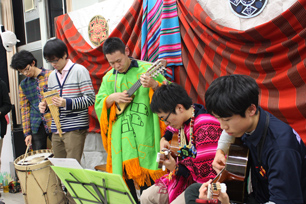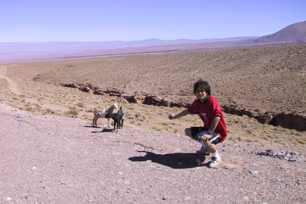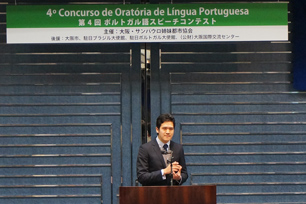Keio University and Latin America –Welcome to Fascinating Latin America (3)
Personal Experiences of Latin America (1)
Playing Folclore Music
Nanao Sakamoto (Second-year student, Faculty of Economics) Representative, The Latin American Music Society

Are you familiar with folclore?
Primarily this refers to any folk music, but in Japan it often means specifically Latin American Folk Music. At the Keio University student group, the Latin American Music Society, we perform folclore of the tableland regions of Bolivia and Peru, so that the wind of the Andes can blow through Keio University.
First, let's take a look at the instruments used. Musical performances are primarily comprised of five instruments. The quena, a vertical flute made of bamboo or reeds. The zampoña, a panpipe which has a row of reed pipes. The charango which has ten strings and resonates a high pitch. The deep bass sounds of the percussion instrument, the bombo. Finally, the instrument that everyone is familiar with, the classical guitar.
All of these are essential for the kind of Latin American folk music that we play. There are a variety of reasons for joining the Latin American Music Society such as being moved when hearing a performance, being captivated by the sound of the quena, or wanting to capitalize on guitar playing experience. But whatever the reason, I think part of it stems from a feeling of wanting to start something new.
Latin American melodies are not so familiar to Japanese people, but it is a beautiful thing when even people without experience in playing music can join and be able to enjoy folclore. Folclore allows you to enjoy using your entire body in dance, playing music and song, so why not consider stepping into this world?
Personal Experiences of Latin America (2)
Chile and Me
Associate Professor Tomoharu Oka, Department of Physics, Faculty of Science and Technology

Because of my work, sometimes I go to Chile. It's very far. From Narita it takes a whole day with an international connecting flight, and when I see the reddish brown earth below, I know it is the capital city Santiago.
A large portion of this unusually-shaped long and thin country is an arid region, and to the east are the steep mountain ranges of the Andes. There is a mountain that looks just like Mt. Fuji, only it is 2000 meters higher.
Dry places at high altitudes are known to be perfect places for astronomical observation, and in the mountains of Chile there are many cutting-edge observatories. That is where I make my observations of the center of the Milky Way.
On the other hand, the ideal conditions for astronomical observation are completely unkind to humans. For most forms of life, water and air is essential. Especially for us Japanese who were raised in a warm, humid climate, after one week our skin becomes dry and we can start to have problems with our breathing.
And yet, the Chilean people who live in these harsh areas are incredibly cheerful. It seems that their way of thinking about life is fundamentally different to ours. In general, they are not punctual and their work is not always perfect, but everyone looks like they are enjoying life.
Their main form of amusement, as is the case for so many South Americans, is soccer. One time I was invited by the hotel staff to join in a game, but I thought I was dying due to a lack of oxygen. The altitude there, by the way, was 2400 meters. I don't want to play soccer with South Americans anymore.
There are also annoying insects such as the assassin bug which can carry an incurable disease called Chagas disease. If you miss it when it is contracted, there are no known effective treatments. It's scary because after being infected, you can show no symptoms for a few years or even decades, and when the symptoms start appearing death comes swiftly. I have always been careful, but I wonder, will I be okay?
Personal Experiences of Latin America (3)
"Creating Another Brazil": for the Future of Japan-Brazil Relations
Jun Kuboyama (Second-year student, Department of Political Science, Faculty of Law)

"I want to go to Brazil." It was just this vague thought that I held that introduced me to Brazil. In my second year of high school, I decided to study abroad for one year in Brazil, and before long I was captivated by the charm of the country.
After I returned to Japan, in March of last year, I organized the first Japan-Brazil High School Future Summit in Hamamatsu City, based on the idea of wanting to improve future Japan-Brazil relations. I thought that the Brazilian and Japanese junior high and high school students in Japan who will play an important role in Japan-Brazil relations ten years from now, must share the opportunity to learn more about a Brazil they aren’t familiar with yet, and discuss the future of Japan-Brazil relations.
Japanese-Brazilian communities are assets to both countries, but if those communities simply just "exist," then it becomes meaningless. More than a century has passed since the beginning of Japanese immigration to Brazil, and on this turning point where Japan-Brazil relations are becoming increasingly ingrained, I am reminded that there is a “Brazil” in Japan—the Japanese-Brazilian community—and I think that our union is a step towards rebuilding Japan-Brazil relations.
Taking these thoughts to heart, this year in January I entered a Portuguese language speech contest in Osaka. In the speech I relayed my thoughts about seeing new Japan-Brazil relations through our union with Brazilians living in Japan. I was able to win the speech contest and I am planning to travel to Brazil again in August as an Osaka City goodwill ambassador.
I know that I can only do so much, but even if it's just a small amount, I hope I can make some contribution to Japan-Brazil relations.
